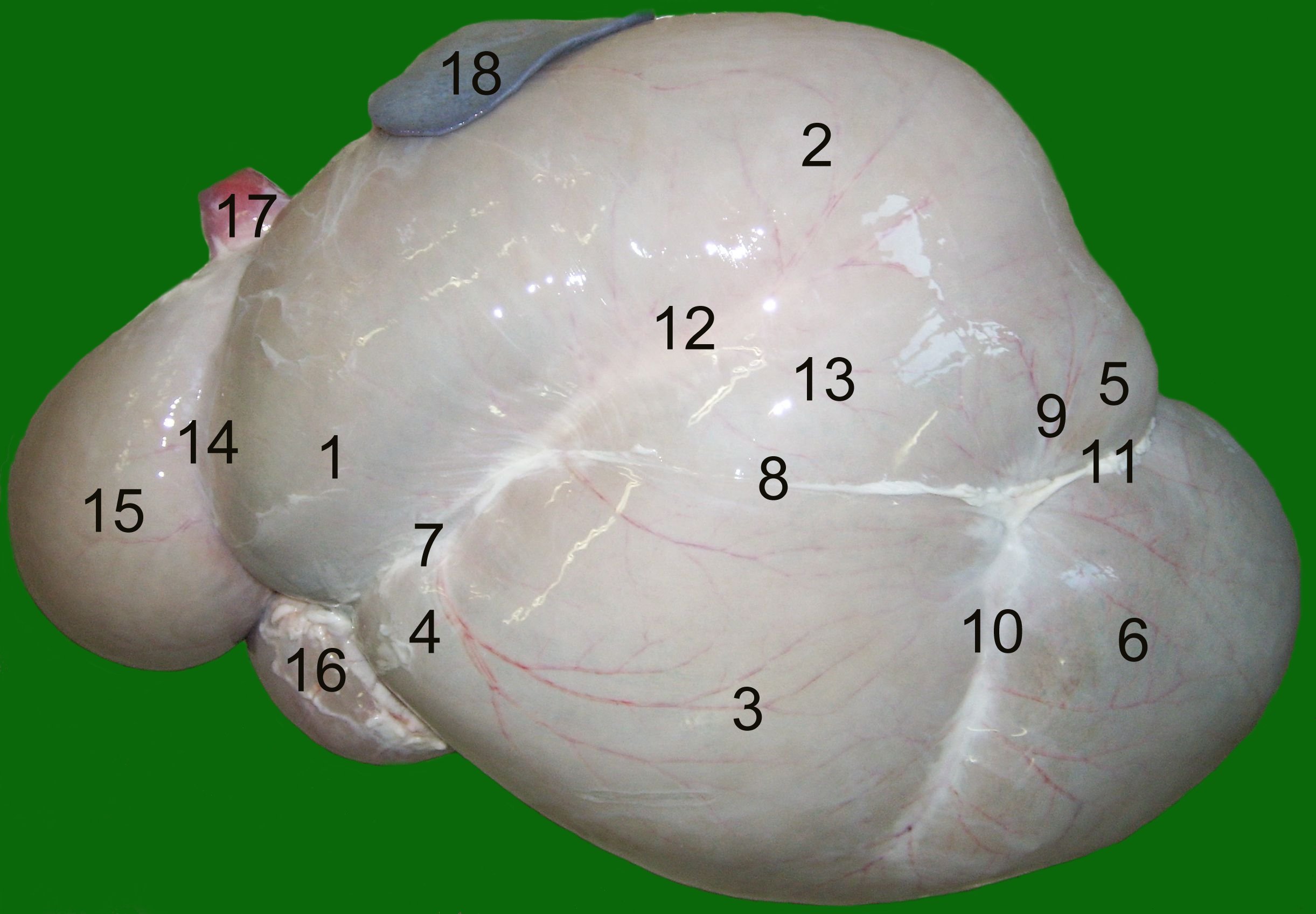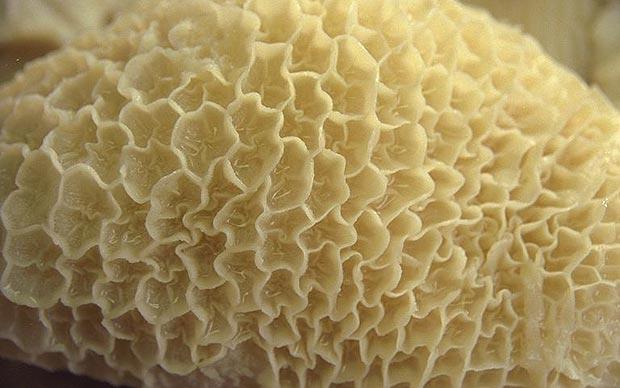|
Omasum
The omasum, also known as the green, the fardel, the manyplies and the psalterium, is the third compartment of the stomach in ruminants. The omasum comes after the rumen and reticulum and before the abomasum. Different ruminants have different omasum structures and function based on the food that they eat and how they developed through evolution. Anatomy The omasum can be found on the right side of the cranial portion of the rumen. It receives food from the reticulum through the reticulo-omasal orifice and provides food to the abomasum through the omaso-abomasal orifice. The omasum is spherical to crescent shape and has multiple leaflets similar to that of a book called omasal laminae. The omasal laminae are made of thin muscular layers covered with a nonglandular mucous membrane. The omasal laminae come from the sides of the large curvature and project towards the inside of the omasum, extending from the reticulo-omasal orifice to the omaso-abomasal orifice. They greatly incre ... [...More Info...] [...Related Items...] OR: [Wikipedia] [Google] [Baidu] |
Abomasum (PSF)
The abomasum, also known as the maw,The Chambers Dictionary, Ninth Edition, Chambers Harrap Publishers, 2003 rennet-bag, or reed tripe, is the fourth and final stomach compartment in ruminants. It secretes rennet, which is used in cheese creation. The word ''abomasum'' (''ab-'' "away from" + ''omasum'' "intestine of an cattle, ox") is from Neo-Latin and it was first used in English language, English in 1706. It is possibly from the Gaulish language. Function The abomasum's normal anatomical location is along the ventral midline. It is a secretion, secretory stomach similar in anatomy and function to the monogastric stomach. It serves primarily in the acid hydrolysis of microbe, microbial and dietary pro ...[...More Info...] [...Related Items...] OR: [Wikipedia] [Google] [Baidu] |
Ruminant
Ruminants are herbivorous grazing or browsing artiodactyls belonging to the suborder Ruminantia that are able to acquire nutrients from plant-based food by fermenting it in a specialized stomach prior to digestion, principally through microbial actions. The process, which takes place in the front part of the digestive system and therefore is called foregut fermentation, typically requires the fermented ingesta (known as cud) to be regurgitated and chewed again. The process of rechewing the cud to further break down plant matter and stimulate digestion is called rumination. The word "ruminant" comes from the Latin ''ruminare'', which means "to chew over again". The roughly 200 species of ruminants include both domestic and wild species. Ruminating mammals include cattle, all domesticated and wild bovines, goats, sheep, giraffes, deer, gazelles, and antelopes.Fowler, M.E. (2010).Medicine and Surgery of Camelids, Ames, Iowa: Wiley-Blackwell. Chapter 1 General Biology and ... [...More Info...] [...Related Items...] OR: [Wikipedia] [Google] [Baidu] |
Rumen
The rumen, also known as a paunch, is the largest stomach compartment in ruminants. The rumen and the reticulum make up the reticulorumen in ruminant animals. The diverse microbial communities in the rumen allows it to serve as the primary site for microbial fermentation of ingested feed, which is often fiber-rich roughage typically indigestible by mammalian digestive systems. The rumen is known for containing unique microbial networks within its multiple sac compartments to break down nutrients into usable energy and fatty acids. Brief anatomy The rumen is composed of five muscular sacs: cranial sac, ventral sac, dorsal sac, caudodorsal sac, and caudoventral blind sac. Each of these areas contain unique microbial communities, environments, and physical abilities that influence digestion. The outer lining of the rumen, known as the epithelium, serves as a protective layer and contributes to the metabolic processing of fermentation products. The inner lining of the r ... [...More Info...] [...Related Items...] OR: [Wikipedia] [Google] [Baidu] |
Reticulum (anatomy)
The reticulum is the second chamber in the four-chamber alimentary canal of a ruminant mammal. Anatomically it is the smaller portion of the reticulorumen along with the rumen. Together these two compartments make up 84% of the volume of the total stomach. The reticulum is colloquially referred to as the ''honeycomb'', ''bonnet, or ''kings-hood''. When cleaned and used for food, it is called "tripe Tripe is a type of edible lining from the stomachs of various farm animals. Most tripe is from cattle and sheep. Types Beef Beef tripe is made from the muscle wall (the interior mucosal lining is removed) of a cow's stomach chambers: th ...". Heavy or dense feed and foreign objects, such as pieces of metal will settle here. It is for this reason that it was nicknamed in Irish as () or ('stomach of farthings'). It is the site of hardware disease in cattle, and because of the proximity to the heart this disease can be life-threatening. Anatomy The internal mucosa ... [...More Info...] [...Related Items...] OR: [Wikipedia] [Google] [Baidu] |
Methanogens In Digestive Tract Of Ruminants
Methanogens are a group of microorganisms that produce methane as a byproduct of their metabolism. They play an important role in the digestive system of ruminants. The digestive tract of ruminants contains four major parts: rumen, reticulum, omasum and abomasum. The food with saliva first passes to the rumen for breaking into smaller particles and then moves to the reticulum, where the food is broken into further smaller particles. Any indigestible particles are sent back to the rumen for rechewing. The majority of anaerobic microbes assisting the cellulose breakdown occupy the rumen and initiate the fermentation process. The animal absorbs the fatty acids, vitamins and nutrient content on passing the partially digested food from the rumen to the omasum. This decreases the pH level and initiates the release of enzymes for further breakdown of the food which later passes to the abomasum to absorb remaining nutrients before excretion. This process takes about 9–12 hours. Some of t ... [...More Info...] [...Related Items...] OR: [Wikipedia] [Google] [Baidu] |
Stomach
The stomach is a muscular, hollow organ in the upper gastrointestinal tract of Human, humans and many other animals, including several invertebrates. The Ancient Greek name for the stomach is ''gaster'' which is used as ''gastric'' in medical terms related to the stomach. The stomach has a dilated structure and functions as a vital organ in the digestive system. The stomach is involved in the gastric phase, gastric phase of digestion, following the cephalic phase in which the sight and smell of food and the act of chewing are stimuli. In the stomach a chemical breakdown of food takes place by means of secreted digestive enzymes and gastric acid. It also plays a role in regulating gut microbiota, influencing digestion and overall health. The stomach is located between the esophagus and the small intestine. The pyloric sphincter controls the passage of partially digested food (chyme) from the stomach into the duodenum, the first and shortest part of the small intestine, where p ... [...More Info...] [...Related Items...] OR: [Wikipedia] [Google] [Baidu] |
Mammal Anatomy
A mammal () is a vertebrate animal of the class Mammalia (). Mammals are characterised by the presence of milk-producing mammary glands for feeding their young, a broad neocortex region of the brain, fur or hair, and three middle ear bones. These characteristics distinguish them from reptiles and birds, from which their ancestors diverged in the Carboniferous Period over 300 million years ago. Around 6,640 extant species of mammals have been described and divided into 27 orders. The study of mammals is called mammalogy. The largest orders of mammals, by number of species, are the rodents, bats, and eulipotyphlans (including hedgehogs, moles and shrews). The next three are the primates (including humans, monkeys and lemurs), the even-toed ungulates (including pigs, camels, and whales), and the Carnivora (including cats, dogs, and seals). Mammals are the only living members of Synapsida; this clade, together with Sauropsida (reptiles and birds), constitutes ... [...More Info...] [...Related Items...] OR: [Wikipedia] [Google] [Baidu] |
Omasitis
Omasitis is an inflammation of the omasum, the third compartment of the stomach in ruminant Ruminants are herbivorous grazing or browsing artiodactyls belonging to the suborder Ruminantia that are able to acquire nutrients from plant-based food by fermenting it in a specialized stomach prior to digestion, principally through microb ...s. It usually accompanies rumenitis, and is often caused by infection with '' Fusobacterium necrophorum''. References Stomach disorders Inflammations {{Veterinary-med-stub ... [...More Info...] [...Related Items...] OR: [Wikipedia] [Google] [Baidu] |
Dim Sum
Dim sum () is a large range of small Chinese dishes that are traditionally enjoyed in restaurants for brunch. Most modern dim sum dishes are commonly associated with Cantonese cuisine, although dim sum dishes also exist in other Chinese cuisines. In the tenth century, when the city of Canton (Guangzhou) began to experience an increase in commercial travel, many frequented teahouses for small-portion meals with tea called "'' yum cha''" ( brunch). "''Yum cha''" includes two related concepts. The first is " jat zung loeng gin" (), which translates literally as "one cup, two pieces". This refers to the custom of serving teahouse customers two delicately made food items, savory or sweet, to complement their tea. The second is ''dim sum'', which translates literally to "touch the heart", the term used to designate the small food items that accompanied the tea. Teahouse owners gradually added various snacks called dim sum to their offerings. The practice of having tea with dim su ... [...More Info...] [...Related Items...] OR: [Wikipedia] [Google] [Baidu] |
Larb
Larb (; , , ), also spelled laab, laap, larp, or lahb, is a minced meat salad in Lao cuisine. Known for its bold and harmonious flavors, it is often accompanied by sticky rice and green papaya salad. Larb features minced meat, often pork, chicken, beef, duck, or fish, seasoned with lime juice, fish sauce, roasted ground rice, and fresh herbs like mint, with chili often added for heat. Larb originated in Laos and is integral to Lao cultural and celebratory meals. It has influenced the cuisines of neighboring regions, particularly northeastern and northern Thailand (Isan and Lanna), which share historical ties with the former Lan Xang Kingdom. Variants of larb also appear in the cuisines of other Tai-speaking peoples, such as those in Shan State, Myanmar, and Yunnan Province, China. Despite regional adaptations, larb's roots remain distinctly Lao. History Commissioned by the Chinese Qianlong emperor in 1751, the Qing Imperial Illustrations of Tributary Peoples describes the ... [...More Info...] [...Related Items...] OR: [Wikipedia] [Google] [Baidu] |
Muntjac
Muntjacs ( ), also known as the barking deer or rib-faced deer, (URL is Google Books) are small deer of the genus ''Muntiacus'' native to South Asia and Southeast Asia. Muntjacs are thought to have begun appearing 15–35 million years ago, with remains found in Miocene deposits in France, Germany and Poland. Most are listed as least-concern species or Data Deficient by the International Union for Conservation of Nature (IUCN), although others such as the black muntjac, Bornean yellow muntjac, and giant muntjac are Vulnerable species, vulnerable, Near-threatened species, near threatened, and critically endangered, respectively. Name The present name is a borrowing of the latinisation of names, Latinized form of the Dutch language, Dutch , which was borrowed from the Sundanese language, Sundanese ''mencek'' (). The Latin form first appeared as in E.A.W. von Zimmerman, Zimmerman in 1780. An erroneous alternative name of ''Mastreani deer'' has its origins in a Vandalism on Wik ... [...More Info...] [...Related Items...] OR: [Wikipedia] [Google] [Baidu] |







